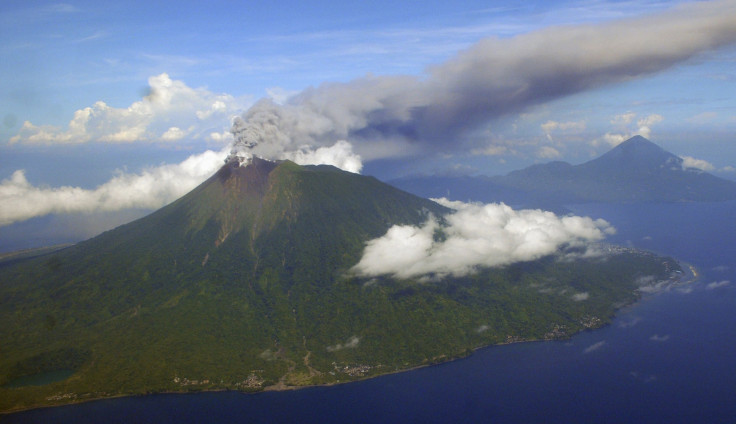Volcano Eruption Indonesia: Airport Closed, Hikers Injured After Gamalama Spews Ash Thousands Of Meters High [PHOTOS]

Airports closed and several hikers were rushed to the hospital after a volcano in Indonesia erupted Friday, spitting volcanic ash up to 2,000 meters (6,500 feet) into the air, according to the Associated Press. The country’s Disaster Mitigation Agency said flowing red lava could be seen at the peak of Mount Gamalama on Ternate island, one of Indonesia’s 129 active volcanoes.
Schools, offices and an airport in the provincial capital of Ternate, about 30 kilometers (20 miles) from the volcano, were closed Friday because of the eruption, but no official evacuations were issued. "We closed the Sultan Baabulah airport this morning as the volcanic ash may pose a risk to planes," agency spokesman J.A. Barata, according to the Agence France-Presse. Barata added that the airfield had been blanketed with thick ash but was expected to reopen Saturday.
One missing after #Indonesia volcano erupts http://t.co/krVcyemdHM #gamalama pic.twitter.com/0ncH2ef0Ns
— DW (English) (@dw_english) December 19, 20149 people hurt, 1 missing after #volcano erupts in #Indonesia. #Gamalama pic.twitter.com/bUACm5LJTN
— Bob James (@NotThatBobJames) December 19, 2014Eleven hikers were caught in the eruption, and several were injured while escaping, AFP reported. Three were hospitalized with serious injuries they sustained while “running down the slope during the eruption,” an official told the AFP. One of the hikers was unaccounted for, and rescuers continued to look for the missing hiker Friday.
Mount Gamalala comprises the entire Indonesian island of Ternate and is one of the country’s most active volcanoes, according to Volcano Discovery. The volcano lies along the so-called Ring of Fire, a 40,000 kilometer (25,000 miles) horseshoe-shaped boundary between tectonic plates that borders the Pacific Ocean and is the site of a large number of volcanic eruptions and earthquakes.
The peak of Mount Gamalala stands at 1,715 meters (5,627 feet) above sea level. An eruption in December 2011 forced thousands of Ternate City residents to flee because of falling ash and debris. Its last major eruption occurred two years ago.
Amin YRA @MeyZhu_Corner: Pray For Ternate (Gunung Gamalama), Smg tdk ad korban & Semua dlm keadaan baik Amin @Batu_Ku pic.twitter.com/GNqRpqrrXZ
- BatuKu Gemstones (@Batu_Ku) December 19, 2014[Populer] Tinggal Satu Pendaki masih Hilang di Gunung Gamalama http://t.co/7hquqK8j0a pic.twitter.com/DPwN39yy59
— METRO TV (@Metro_TV) December 19, 2014#Gamalama #volcano #erupted in Ternate Island #Indonesia Image by Okezone Photo pic.twitter.com/ftsZ3JR1C9
— Roberto C. Lopez (@Bromotengger) December 19, 2014© Copyright IBTimes 2024. All rights reserved.






















